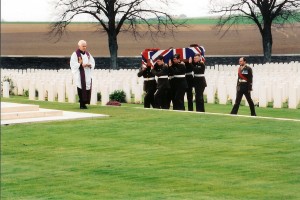US 1st Infantry Division (WW II)
This Virtual Battlefield Tour presents the locations of the numerous commemorations in Europe to the men of the 1st Infantry Division.
Unit History:
The US 1st Infantry Division is the oldest division in the United States Army with units dating back to the American Revolution. It was the first American unit to arrive on the First World War battlefield. Units of the division fired the first artillery shot of the American Expeditionary Corps and suffered the first three soldiers killed. In 1918 it launched America’s first offensive operation against the Germans at Cantigny. In September the entire division was committed in the Battle of the Mihiel Salient and only two weeks later in the decisive Meuse-Argonne Offensive where it fought as far east as Sedan. The unit insignia provides its nickname as well, a ‘Big Red One’ on a brown/ grey background.
The division entered Second World War when it landed near Oran, Algeria on 8 November 1942. It fought in North Africa under the Tunisian garrison surrender on 9 May 1943. In July 1943, it landed in Sicily and fought in the brutal mountain campaign. The Big Red One returned to England for refitting and led the Normandy Invasion by being the first infantry unit on Omaha Beach. It continued to participate in the Normandy fighting and across France to the German border near Aachen, where it captured the first German city by direct infantry assault. The 1st fought in the Hürtgen Forest until, completely exhausted after almost six months of continuous fighting, its men were moved back on 7 December. The German Ardennes Offensive was launched nine days later and the 1st Infantry was quickly called back into action. It fought in the Ardennes, broke through the Siegfried Line, and crossed the Rhine at the Remagen bridgehead. The unit was fighting in Czechoslovakia when the war ended.
Motto: “No Mission Too Difficult, No Sacrifice Too Great—Duty First!”
View US 1st Infantry Division (WW II) – A Virtual Battlefield Tour by French Battlefields (www.frenchbattlefields.com) in a larger map

